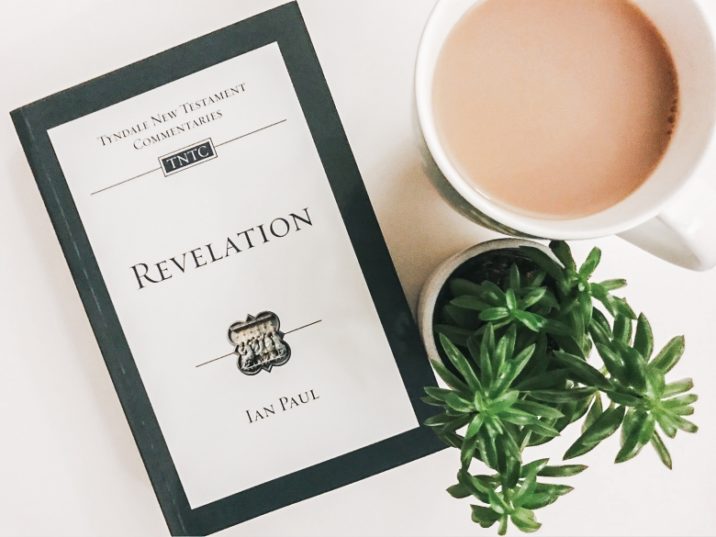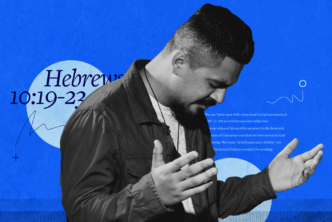Earlier this month, Ian Paul gave a paper at the annual meeting of the British New Testament Society, in the Revelation seminar group, on his experience of writing a commentary. This is what he said.
The Task
I was contracted to write the Tyndale commentary on the Book of Revelation published by IVP as part of their rapid revision of the whole Old and New Testament series, which had been delayed by the production of a previous revision to the OT series. The previous volume in this series had been the slightly revised version of the original 1968 edition by Leon Morris, so it had been very out of date and was written by a non-Revelation-specialist.
The task was quite a challenge, in that it was a medium sized commentary (planned at 135,000 words, nearly twice the previous one, but which came out at 144,000 words!) but was designed to be for general use, so needed mostly to avoid footnotes and technical discussion. I felt the weight of this task, in being aware that the intended readership could have a diverse range of views on Revelation, and that resolving different views often relied on making reference to quite technical issues. I also wanted to ensure that, for academic readers, my engagement with the text would stand up to scrutiny.
The Process
As is my wont, I was well behind on the contract date for delivery, and so had to write to a deadline of July 2017. Although I have continued to be research active, and had been doing preparatory work over the previous two years, the main writing period was from November 2016 to July 2017. The final text was published in April 2018 in the UK, and July 2018 in the US.
One major advantage of writing a commentary, in contrast to other research projects, is that the structure is more or less a given. IVP had a very specific structure that they required for this new version of the series, which involved breaking the text into book chapters, including an introductory contextual comment to each section, and concluding with theological reflection. This structure did not work very well with Revelation, since the narrative flow and structuring of the text does not always work well with Stephen Langton’s 1227 chapter divisions. This meant that I had to make some significant revisions in November 2017 in response to the series editor’s feedback.
I wanted to give even attention to the different parts of the text, since I think that the evidence of the text itself is that it is highly recursive and intratextual, so no one portion should be given significantly greater attention than any other. ‘Doing the math’ meant that the overall length, minus the introduction of around 24,000 words, allowed me an average of 274 words per verse, and this functioned as a practical guide to my planning and writing. On my allocated writing days, I needed to write commentary on 8 verses, totalling around 2,200 words. This looked achievable, given some online discussion about the pace at which Biblical Studies academics worked (most agreed that around 1,000 words was manageable in a full day, though Craig Keener once wrote a 7,000 word academic article in a day!).
I found the most fruitful way to write was to start early, and I usually aimed to get to my desk by 6.30 or 7.00 am, and complete 1,000 words of writing before breakfast and walking the dog at 9 am. From personal conversation, I knew that Scot McKnight plans his writing days to run from 7 am to 2 pm, after which he stops work. If I managed to complete the other 1,000 words by lunch time, it was both liberating and highly motivating—despite the fact that for most of my life up until 2013 I had been more of a ‘night owl’!
In engaging with the text, I had a small group of key conversation partners, and a second group of more occasional sources that I consulted.
David Mathewson, Baylor Handbook to the Greek Text of Revelation. This was an invaluable aid to making my own translation of the text, which I used about 50% of the time in the commentary (in slight breach of IVP’s guidelines!), and in particular thinking about the grammatical anomalies in the text.
Craig Koester Anchor Bible: Revelation. I think this is now probably the best long commentary on the text; Koester consistently sets out the range of possible options for reading difficult texts, and gives reasons why he takes the option that he does. There were three major points where I disagreed with him (see below).
Gordon Fee, New Covenant Commentary. An interesting narrative commentary writing in a theological tradition close to mine, but without very close attention to the details of the text.
Craig Keener, NIV Application Commentary. This is quite an unusual commentary that combines close attention to the text, a wealth of historical background material, and contemporary application and illustration. Craig told me that he was only able to include about half of his research material in the final text!
Grant Osborne, Baker Exegetical Commentary. Close attention to the text, though pushed out of shape by Osborne’s theological concerns and context.
I also consulted Aune, Beale, Boxall, Caird, Charles, Leithart, Mounce, Resseguie, Smalley, Swete, Thomas, and Witherington at different times on different issues. I drew on both my PhD thesis, and the 18 papers I have published and 36 articles written on my website. I have about 180 volumes on Revelation in my personal library—but use of other volumes was limited because of this being a non-technical commentary. There was also little scope to draw on journal articles, which would be essential in a more academically-oriented work.
The Approach
My approach to the commentary was to be relentlessly text focussed. This was in part because it would be the most appropriate approach given the constituency that the commentary was aimed at. But it was also because my own conviction about Revelation is that much commentary and interpretation takes insufficient account of the actual data of the text.
This meant that my reading was very different from an ideological reading, such as that of Stephen Moore (whom I have been re-reading recently). Moore approaches the text from an explicit Queer ideological standpoint, and the effect is to produce a neo-Freudian critique of what the text is ‘really’ saying, deploying a hermeneutic of intense suspicion which often interprets the text either in the absence of textual evidence or even against the evidence of the text. For example, in his essay ‘Hypermasculinity and Divinity’, Moore claims (against almost every other commentator) that Revelation’s depiction of the one seated on the throne is highly anthropomorphic, and indeed has a parallel in the static, posing musculature of modern body builders. The image of the New Jerusalem is a claustrophobic, mirrored training room, where the image of God is reflected back to the deity in an irredeemable exercise of cosmic narcissism. I am not convinced that the data of the text supports this reading.
But my commitment to the priority of the text also put me in tension with readings that have been quite common in the constituency which I was addressing. I am frequently asked, for example, whether my approach to the text in general is ‘futurist, church historical, idealist or preterist’, and whether I approach the millennium in chapter 20 from a premillenial, dispensationalist, postmillennial, or amillenial point of view. I obstinately insist in response that these understandings, if they do have merit, must emerge from the text, and not be taken as presuppositions prior to reading the text itself. I therefore resist (in the introduction) doing anything more than note these possible approaches, and the virtues and problems of each.
My commitment to the text also raised (and solved) a significant theological issue when the text was accepted for translation into French for the French Protestant church. The organisation overseeing the translation raised a concern with IVP UK that my reading of the judgement texts in the last chapters appeared to support what has been labelled an ‘annihilationist’ view of divine judgement. In response, I pointed out that I had simply taken a disciplined approach to how the text should be read in its historical, cultural and canonical context, and actually held back from drawing out too strongly a particular theological position that might arise. It seemed to me that, if the reasonably construed meaning of the text did not support the organisation’s theological position, so much the worse for the position! I was not willing to edit my comments without good reason.
Careful attention to the text has also yielded some interesting and novel observations. As part of my PhD, I noted that the grammatically unusual phrase οὐδὲ τόπος εὑρέθη αὐτῶν ἔτι (Rev 12.8) is an almost exact citation of Dan 2.35 (LXX Theodotion) and Ps 36.36 LXX (Ps 37.36 MT), and thus follows a trajectory of interpretation also found in Qumran—something that has not been previously observed. In writing the commentary, I noted the odd presence of the ‘angel’ in the ‘chain of revelation’ in Rev 1.1 who is subsequently never referred to, and this contributes to the distinct function of the angels in the text who are self-effacing and function merely as literary supporters of the structure and communication of the message. To my knowledge, no extant commentator notices this mention of an angel or how odd it is.
Issues arising
One of the major challenges in writing a commentary is that you are forced to have a view on every element of the text, where an academic approach to research allows you to focus on areas of specialist interest and avoid issues that are unpleasant, uncomfortable or too complex! The sections I found most challenging to write about included chapter 9 and the vision of the creatures from the abyss, and the bowls sequence in chapter 16. I was persuaded of the importance of contemporary mythological imagery in making sense of chapter 9, and realized the importance not only of the Exodus plague imagery in chapter 16 (which is widely noted, and sets the bowls sequence apart from both the seals sequence in chapter 6 and the trumpet sequence in chapters 8 and 9) but also its strong literary connections with chapter 18, which is often given less prominence.
I experienced some trepidation in dissenting from the view of Craig Koester at three important points, since in all other respects I found his approach to the text robust and convincing. First, commentators are generally divided quite evenly on the function of the ‘seven spirits before the throne’ introduced in Rev 1.4 (καὶ ἀπὸ τῶν ἑπτὰ πνευμάτων ἃ ἐνώπιον τοῦ θρόνου αὐτοῦ) and I sided with Bauckham and others against Koester and others in believing this is a part of a proto-trinitarian formulation—though on textual rather dogmatic or theological grounds. Secondly, Koester argues that the ‘spewing out of my mouth’ (μέλλω σε ἐμέσαι ἐκ τοῦ στόματός μου) in Rev 3.16 relates more to expectoration and vomiting as part of Roman meal practices than to the undrinkable, calcified water of Laodicea, but I think this arises from his misreading of Strabo’s Geographica at this point. My disagreement here merited my longest single footnote in the whole commentary.
Thirdly, Koester argues that the trumpeting of the seventh trumpet in Rev 11.15 must be the coming the ‘third woe’, even though the text itself does not say so! I agreed with a small minority of commentators in noticing the next occurrence of the term ‘woe’, in Rev 12.12, but I was alone in also noting the wide numerological dynamic here: ‘woe’ occurs precisely 14 times in all in the whole text (and I don’t think there are any textual variants that would affect this); six of these occurrences come in chapter 18, where we have a triple occurrence of a slightly odd double woe (by each of the kings of the earth, the sea captains, and the merchants); and together this strongly argues for seeing the omission of and explicit reference to the third woe, and the inclusion of ‘woe’ in Rev 12.12, as a deliberate part of the narrative design by the author. As I have observed elsewhere, this offers insight both into the narrative use of disruption, where the author sets up a narrative expectation which is then either not fulfilled or seriously disrupted, and tells us something about Revelation’s construal of space and time, locating John and his readers theologically within the space between the sixth and seventh trumpets.
Related to these disagreements, I also propose in the commentary a unique reading of the citations of Zechariah and Daniel in Rev 1.7, in which the ‘coming on the clouds’ alludes to Jesus’ ascension and does not look ahead to his eschatological return. All commentators I have consulted assimilate this text to the only other allusion to these two OT texts, in Matt 24.30, and take it to be eschatological, without considering the argument of George Caird and Dick France that this Matthean text is actually about the ascension. In the commentary I only had space to summarise my argument, so whilst writing the commentary I set out the fuller case in a blog article ‘When is God “coming on the clouds”?’ at https://www.psephizo.com/revelation/when-is-god-coming-on-the-clouds/ Generally positive response to this argument online gave me confidence to include this in the commentary even without having the means to offer a more robust defence in the text. (IVP reluctantly conceded that I could reference the blog in the book!)
More generally, writing a commentary that seeks to bridge the world of academic engagement with more ‘devotional’ engagement offers a fascinating exercise in putting one’s approach to a text in a place of public scrutiny. I have had correspondence about both detailed and general aspects of my reading from across the spectrum of both theological views and varying levels of academic engagement. I am pleased to report that, so far, I haven’t had to confess to any major blunders!
The final distinctive that I sought to offer was in the Introduction. The intended constituency for the commentary has traditionally been very interested in questions of authorship and dating; whilst I offered plenty of information in relation to both of these, I also wanted to highlight how little such questions actually affected most elements of most reading strategies, and how often such arguments ended up being circular (‘notice this in the text, which points to date X; given the date X, this element of the text must mean this…’) When speaking about Revelation in non-academic contexts, one of the persistent questions relates to the nature of John’s revelatory experience, and assumptions about this experience in turn shape approaches to interpretation. And yet there is very little reflection on theses issues in most commentary introductions. I was therefore determined to include a section under the heading ‘Did John actually have a vision?’ which I think will surprise some of my readers!
I also included much more coverage of questions of material culture (influence by the work of Steven Friesen, Bruce Longenecker and Peter Oakes) which is missing from other commentary introductions but I think informs our reading of the text, and in particular its anthropology, and I also made exploration of numerology more prominent both in the introduction and in the body of the commentary itself.
In addition, my interest in the role and function of metaphor in the text, arising from my original PhD research, shaped my reading at every stage.
Conclusion
Writing the commentary was both a demanding and an exhilarating experience, both academically and, for me, spiritually. I would love to write a longer volume on Revelation or write commentary on other biblical texts. A central part of my vocation is to try and bridge the worlds of the academy and devotional approaches to reading the Bible, and writing a commentary is an excellent way of doing that.
From a personal point of view, the whole process was a remarkable spiritual experience. To spend such an extended time immersed so deeply in a text of Scripture was a wonderful experience, and a number of my writing weeks offered me a profound sense of being in the presence of God. I hope to repeat the experience in future commentary writing.
You can purchase Ian Paul’s Revelation for your Logos Digital Library. This article was first published at Ian Paul’s blog Psephizo on September 23, 2019 here.





